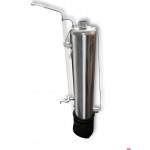
Pressure and Temperature in a Home Autoclave
A home autoclave helps homemakers greatly simplify the canning process and save time. The cooking process occurs under pressure higher than atmospheric and at temperatures above 100°C. This is necessary to sterilize the canned goods from pathogenic microorganisms, ensuring product safety and extending shelf life.
During sterilization in the autoclave, high pressure is created, and since the device is tightly sealed, neither liquid nor air can escape.
To eliminate all harmful bacteria, the product needs to be boiled at a temperature of at least 100°C for a minimum of 20 minutes. Some types of pathogenic organisms, including botulism toxin, can survive under such conditions. The autoclave allows the use of higher temperatures, at which all bacteria are killed.
The drawback of this method is that canned goods can burn in the autoclave if left for too long. Always follow the recipe and maintain the temperature and pressure that will kill bacteria but keep the products in a normal and edible state. The pressure at which to cook in an autoclave depends on the type of product and the required temperature. For example, vegetables should not be cooked at temperatures higher than 100°C, while meat should not be processed at less than 110°C. Temperature norms for preparing different products can be found in the cookbook that comes with the autoclave.
If the temperature in the autoclave is increased, the pressure will also rise. These parameters are interconnected. To properly cook products, you need to understand what pressure should be in the autoclave. Accurately determining the relationship between temperature and pressure is impossible because other factors influence the indicators. We offer an introductory table showing the dependence of temperature on the absolute value of pressure.
| P (atm) | T (°C) |
|---|---|
| 1 | 6.7 |
| 1.3 | 45 |
| 2 | 80 |
| 3 | 100 |
| 3.5 | 110 |
| 4.5 | 120 |
| 5.5 | 126 |
| 6 | 132 |
| 8 | 142 |
- Meat – more than 30 minutes;
- Poultry – 27 minutes;
- Fish – 20 minutes;
- Mushrooms – 15 minutes;
- Vegetables – 10 minutes;
- Fruits – up to 8 minutes.
Important! The size of the jars does not affect the temperature and pressure; they remain the same. However, with larger volumes, the cooking time may increase by 5-15 minutes.
Also read:
- Autoclave Operating Modes
- What is an Autoclave
- Autoclave Hydraulic Testing
- How to Use an Autoclave
- How to Choose an Autoclave









